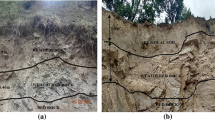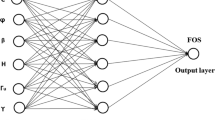Abstract
This study investigates earthen slope stability problems using numerical simulation with limit equilibrium method. For this purpose 250 dataset is generated via Slope/w software in 2D. The generated dataset is used to develop both a regression and artificial neural network (ANN) models. The dependent variables include: the unit weight of soil (\(\gamma\)), soil cohesion (C), soil friction angle (\(\varphi\)), slope of the embankment with horizontal (\(\beta\)) and the height of slope (H). The independent variable comprises the safety factor of the slope against sliding (Fs). A contour set is produced for assessment of the stability of slopes. The performance of the ANN model in terms of R2 and RMSE is assessed 0.99 and 0.08 respectively and shows superior of the ANN in comparison with the classic regression method. Using the derived regression and ANN models, disregard the need for complicated soft wares implementation. This study produces charts that eliminate the necessity for iteration for Fs in simple homogeneous soil slopes.










Similar content being viewed by others
Abbreviations
- C:
-
Soil cohesion (kN/m2)
- F s :
-
Safety factor of the slope against sliding (dimensionless)
- H :
-
Height of slope (m)
- m:
-
Stability number (dimensionless)
- φ :
-
Soil friction angle (°)
- β :
-
Slope of the embankment with horizontal (°)
- γ :
-
Unit weight of soil (kN/m3)
References
Aghajani HF, Salehzadeh H, Shahnazari H (2015) Application of artificial neural network for calculating anisotropic friction angle of sands and effect on slope stability. J Cent South Univ 22:1878–1891
Alavi AH, Gandomi AH (2012) Energy-based numerical models for assessment of soil liquefaction. Geosci Front 3(4):541–555
Erzin Y, Cetin T (2013) The prediction of the critical factor of safety of homogeneous finite slopes using neural networks and multiple regressions. Comput Geosci 51:305–313
Geo-Slope (2007) Stability modelling with SLOPE/W 2007. An engineering methodology, 4th edn. Geo-Slope International Ltd., Calgary
Kainthola A, Verma D, Thareja R, Singh TN (2013) A review on numerical slope stability analysis. Int J Sci Eng Technol Res 2(6):1315–1320
Lim K, Li A, Lyamin A (2014) Slope stability analysis for filled slopes using finite element limit analysis method. In: Conference on soil behaviour and geomechanics, Geo-Shanghai, Shanghai, China, May, pp 615–624
Luo Y, He S, Chen FZ, Li X, He JC (2015) A physical model considered the effect of overland water flow on rainfall-induced shallow landslides. Geoenviron Disasters Springer J 2(8):1–11
Michalowski RL (2002) Stability charts for uniform slopes. J Geotech Geoenviron Eng 128:351–355
Nourani B, Salmasi F, Abbaspour A, Oghati Bakhshayesh B (2017) Numerical investigation of the optimum location for vertical drains in gravity dams. Geotech Geol Eng 35(2):799–808. https://doi.org/10.1007/s10706-016-0144-1
Pradhan B (2011) Use of GIS-based fuzzy logic relations and its cross application to produce landslide susceptibility maps in three test areas in Malaysia. Environ Earth Sci 63(2):329–349
Ramakrishnan D, Singh TN, Verma AK, Gulati A, Tiwari KC (2013) Soft computing and GIS for landslide susceptibility assessment in Tawaghat area, Kuman Himalaya, India. Nat Hazards 65(1):315–330
Razdolsky AG (2009) Slope stability analysis based on the direct comparison of driving forces and resisting forces. Int J Numer Anal Meth Geomech 33:1123–1134
Reddy MJ, Adarsh S (2011) Slope-stability-constrained design of irrigation canals using particle swarm optimization. Irrig Drain 60:590–599
Roushangar K, Akhgar S, Salmasi F, Shiri J (2014) Modelling energy dissipation over stepped spillways using machine learning approaches. J Hydrol 508:254–265. https://doi.org/10.1016/j.jhydrol.2013.10.053
Salmasi F, Sattari MT (2017) Predicting discharge coefficient of rectangular broad-crested Gabion Weir using M5 tree model. Iran J Sci Technol Trans Civ Eng (Shiraz University). https://doi.org/10.1007/s40996-017-0052-5
Salmasi F, Khatibi R, Ghorbani MA (2012) A study of friction factor formulation in pipes using artificial intelligence techniques and explicit equations. Turk J Eng Environ Sci Tubitak 36:121–138. https://doi.org/10.3906/muh-1008-30
Salmasi F, Yıldırım G, Masoodi A, Parsamehr P (2013) Predicting discharge coefficient of compound broad-crested weir by using genetic programming (GP) and artificial neural network (ANN) techniques. Arab J Geosci 6:2709–2717. https://doi.org/10.1007/s12517-012-0540-7
Singh A (1970) Shear strength and stability of san-sade slopes. J Soil Mech Found Div ASCE 96:1879–1892
Verma D, Kainthola A, Thareja R, Singh TN (2013) Stability analysis of an open cut slope in Wardha valley coal field. J Geol Soc India 81:804–812
Author information
Authors and Affiliations
Corresponding author
Additional information
Publisher's Note
Springer Nature remains neutral with regard to jurisdictional claims in published maps and institutional affiliations.
Rights and permissions
About this article
Cite this article
Salmasi, F., Jafari, F. A Simple Direct Method for Prediction of Safety Factor of Homogeneous Finite Slopes. Geotech Geol Eng 37, 3949–3959 (2019). https://doi.org/10.1007/s10706-019-00884-3
Received:
Accepted:
Published:
Issue Date:
DOI: https://doi.org/10.1007/s10706-019-00884-3




